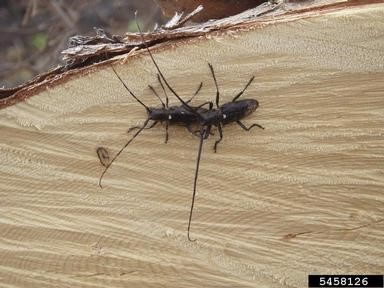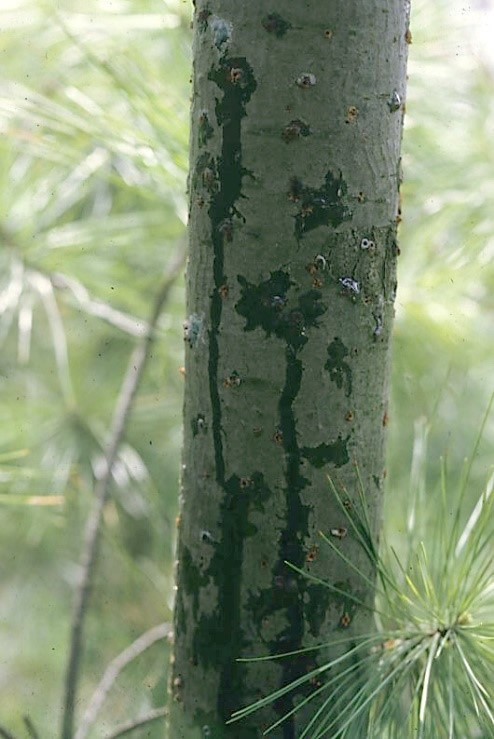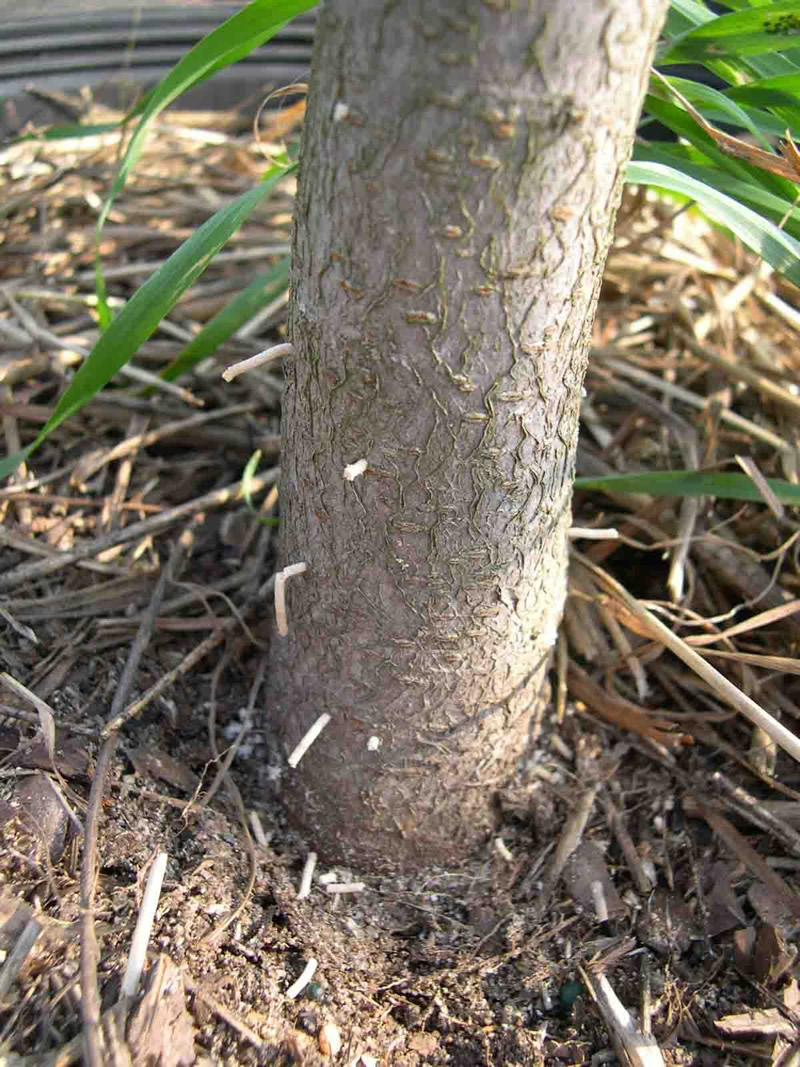Issue 11, September 28, 2020
Pine Beetles
Recently, I’ve received a few inquiries about various beetles on pine trees, so I wanted provide a recourse to our readers understand the injury they’re seeing. This article gives brief descriptions of some common beetles that feed on living, declining and dead pine trees in the Midwest and the type of injury they produce.
Longhorned Beetles
Many of our native longhorned beetles are attracted to stressed trees, including trees that have had branches cut, trees in decline or dead trees. While many of our native longhorned beetles may live on a tree without causing harm or play an important role in decomposition of dead trees, others can cause injury or introduce organisms that cause disease. Longhorned beetle adults leave circular exit holes in tree trunks that vary in diameter depending on the beetle species. Longhorned beetle larvae can also be attractive to woodpeckers which can create rows of holes in the bark as they search for food.

Whitespotted pine sawyer adults (Monochamus scutellatus), Rob Routledge, Sault College, Bugwood.org
Pine Sawyer Beetles
Pine sawyers are pest longhorned beetles that can bore into pine trees and create round exit holes, 3/8 inch diameter, where adults emerge from the trunks of pine trees. Coarse wood shavings and grainy frass (insect droppings) can be found around exit holes. Adult females also chew shallow holes, similar in diameter, into the bark where they lay eggs. Pine sawyer beetles can take up to 2 years to complete their life cycle inside a pine tree, with adults exiting the trees from May through August.
Pest longhorned beetle larvae can cause injury by feeding in the cambium and disrupting nutrient flow. Pine sawyer beetles also have the to potential to introduce nematodes into trees, including the pinewood nematode which can cause pine wilt in Scotch and Austrian pines.
Bark Beetles
Bark beetles often arrive at trees in decline, attracted by chemicals release by the stressed tree. Bark beetles cause pinhead sized holes in the trunk and create distinct galleries under the surface of the bark. There are many species of bark beetles in Illinois, some are decomposers in a dead or dying tree, but others may be pests attacking healthy trees or transmitting disease to the tree.

Bark beetle damage on white pine, Phil Nixon, University of Illinois at Urbana-Champaign
Pine Engraver Beetles
Pine engraver (Ips pini) is a bark beetle that can cause significant tree damage. They cause pinhead-sized holes in the trunk with pitch running from the hole and sawdust-like frass accumulating below the hole. Beetles emerge from the tree from March to October with 3 generations per year. They may also transmit blue stain fungi to trees causing a blue discoloration that can be seen on the wood when a branch or trunk is cut. They are initially attracted to trees in decline but may move to adjacent healthy trees. If one pine tree in a row of pines is in decline, it is recommended to remove that tree to protect the adjacent healthy trees.

Ambrosia beetle toothpicks, Dan Connolly, Illinois Department of Agriculture
Ambrosia Beetles
Ambrosia beetles don’t feed on the wood itself, they cultivate and feed on ambrosia, a fungus that grows with in the beetle galleries. As the beetles feed, their sawdust-like frass is pushed out of small holes to create toothpick-like spikes of frass sticking out of the trunk or branches. This is a good indicator that ambrosia beetles are present. The ambrosia fungus can stain the wood, reducing the value of lumber.
Beetle Identification
There are many bark and boring beetles that are not pests and may not be harming the tree or may be fulfilling their roles as decomposers. Determining what species is present is key to determining if a treatment is needed. Beetles or pictures of galleries can be submitted to UIUC Plant Clinic (https://web.extension.illinois.edu/plantclinic/) for identification by an entomologist and a management strategy can be suggested.
Management
If one tree is in decline and adjacent trees are at risk for infestation, the declining tree can be cut and chipped and a contact insecticide can be sprayed on the surface of the bark of the adjacent healthy trees to prevent infestation.
Systemic treatments usually are not effective in treating pine beetles for three main reasons: 1. Many conifers cannot transport systemic pesticides as broadly as deciduous trees so feeding beetles may not encounter the insecticide. 2. Trees that are already declining may not be able to transport the insecticide because boring beetles have already disrupted the tree’s ability to transport nutrients. 3. The beetles may be in a life stage where they are not feeding in the vascular system of the tree or may be a species that feed on fungi or dead tree material.
Author:
Sarah Hughson